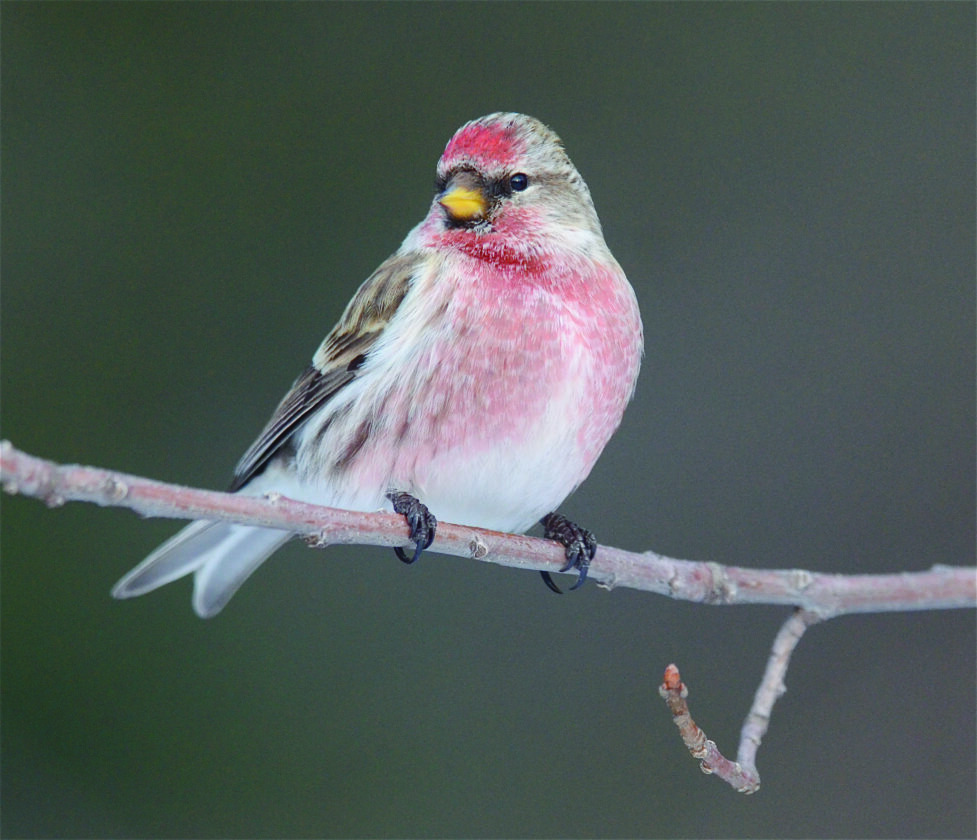What’s Flying: Autumn makes its turn toward winter

A male redpoll looks on. (Scot Stewart photo)
“The thinnest yellow light of November is more warming and exhilarating than any wine they tell of.” – Henry David Thoreau
- STEWART
Autumn is beginning to look more and more like winter in the Upper Peninsula this week. The last of the golden maple, poplar and oak leaves is brings fall to its end. The leaves left on the trees this week are either in areas shielded from the recent extremely strong winds or have truly tenacious holds on their parent branches. That lethal combination of strong winds, colder temperatures and shorter days have sealed the fate of those still holding on before slipping off for the season. A walk through the woods can still yield some isolated trees full of color and many more gracing the ground around them with those blankets of new leaves still in full color.
Along with the end of the fall colors the tail end of bird migration has also begun. It has had some blasts of great numbers of migrators making some early predictions appear to be spot on across the U.P. Winter finches are already on the move into the area. Pine grosbeaks have turned up in small numbers around Marquette with eight the biggest flock at Presque Isle last Tuesday. At Whitefish Point though, 20 were seen the same day. One Wednesday high winds made it difficult to check some areas but the crab apple trees at the entrance to Presque Isle is always a great place to check for them in the early part of the season. In late fall and early winter, the large number crab apple trees in south Marquette keep pine grosbeaks and bohemian waxwings busy for a good stretch some winters, depending on how many descend in the area.
There are still a few robins around and they will make a small dent into the mountain ash and crab apples. Although there have been no reports yet of Townsend’s solitaires, they are another wandering vagrant capable of landing in the U.P. These mostly gray thrush-shaped bird wander eastward from the eastern slope of the Rockies some winters. They are particularly drawn to blackish-blue ripe juniper cones but also eat mountain ash and crab apple fruits. Large junipers have been planted in some yards in Marquette, as well as some parks like Presque Isle and McCarty Cove.
Redpolls are another winter finch currently making their way into Michigan. Fourteen were seen at Presque Isle Wednesday, but at Whitefish Point 151 were counted passing at the tip of the point on Tuesday with another 77 on Wednesday. This year redpoll counts will be a bit different as ornithologists have lumped three named species of redpolls, common and hoary, with a Eurasian species, the lesser redpoll into one, simply called redpoll. For years birders in the U.S. and Canada have struggled distinguishing between the two because they seem to be on a spectrum with varying amounts of streaking, head shapes, and beak sizes sometimes making identifications difficult.

STEWART
Genetic studies finally found a single gene responsible for all the major differences and declared that with just one gene influencing these appearances they would all be considered one species. Birders are really disappointed to learn of these changes because they lose a bird on their life lists but are often delighted to know they no longer will struggle to figure which species some of these intermediary individuals are.
American goldfinches are another finch moving into the area with big flocks. 93 at Presque Isle Tuesday and double-digit flocks have come to several Delta County sites. Similar things happening with snow buntings with 19 seen recently at Portage Point in Delta County, 60 at Whitefish Point, and 93 at Presque Isle in Marquette. The Marquette park also had 23 white-winged crossbills as flocks move across the area in search of full spruce cones. Flocks of evening grosbeaks are also being reported a numerous sites across the U.P.
One of the more unusual sightings this past week was a western grebe seen in Marquette’s Lower Harbor. They are larger grebes, similar in size to red-necked grebes, and have larger bills too. Western grebes summer across most of the western U.S. and can be found in a few places east of the Mississippi River. In winter they head to the Pacific Coast. There is permanent population across much of central Mexico too.
Looking at the daily census reports from Whitefish Point in the first few days this month reveals a strong correlation between wind direction and the number of birds moving past the Point during the fall migration. With winds from the south or southeast, migration drops off. When the wind swings around to the west or northwest, birds sense the benefits of a following wind and migration picks up. This has been particularly true for dabbling ducks like teals and wigeons and divers like scaup, scoters, long-tailed ducks, buffleheads and common goldeneyes. The latter two species have just recently begun to join the migration stream and should start showing up more regularly in Marquette joining plenty of mergansers and long-tailed ducks in the Lower Harbor. It is unfortunate the counters at Whitefish Point will be wrapping up their work next weekend for another season. There will still be occasional reports on eBird from birders visiting the point, but the regular daily reports will come to an end until next April 15 when spring migration counts begin again.
Throughout this time there will still be much to see in the months ahead, most dramatically in the early and late daylight hours. Seeing them in the golden light of late day will be a treat.




